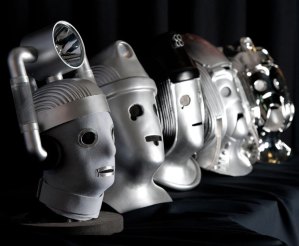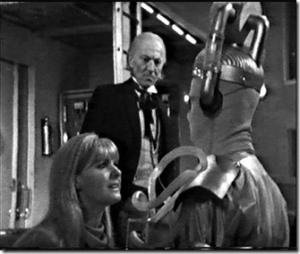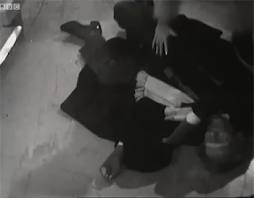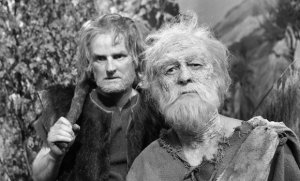Known to most as the first Doctor Who regeneration and the premiere appearance of the Cybermen, it has been persuasively argued by Phil Sandifer in Tardis Eruditorum that The Tenth Planet represents neither. Rather than signalling the First Doctor’s end, Sandifer states that it is rather the demise of the Doctor, per se. Save for his appearance in The Three Doctors, William Hartnell never played the role of the First Doctor. He was always merely “the Doctor” – the original, and some may say, the best. Killed by the energy draining force of the planet Mondas, the Doctor collapses to the floor in his terrifying end. Not only is it the death of the Doctor, but also the death of Doctor Who. Sandifer explains it thus:
“And this is part of being a Doctor Who fan. You are absolutely guaranteed to see the show die in front of you, and then get replaced with a strange, different show using the same name. Eventually, everything that Doctor Who is comes to a crashing halt and something new happens instead”.
The sense of the television series named Doctor Who dying would have been very real to viewers on 29 October 1966. Doctor Who was William Hartnell and William Hartnell was the Doctor. There was no precedent for the change of the lead character in such a radical fashion. Certainly the actor playing a role in a show, whether it be on television or stage, may have changed, but the character remained roughly similar in respect of personality type and more often than not, physical appearance. The most frequently cited similarity, that of the film version of Ian Fleming’s James Bond, was still being played by the first actor to do so, Sean Connery. It would not be until 1969 that George Lazenby would have his one and only outing as 007. Incidentally, it was that very same year that the American series Bewitched saw the character of Darrin Stephens played by a different actor, also with the unfortunate name of Dick. Dick Sargent replaced Dick York, but as in the case of James Bond, Darrin remained ostensibly the same character.
Doctor Who was different, however. This wasn’t the case of a quick change of lead actor, with the series continuing unchanged. This was actually the death of the lead. Although the new lead actor played the role of a character bearing the same name, the Doctor, his personality was remarkably different. There was very much a sense of re-birth and complete renewal. This was particularly evident in The Tenth Planet’s setting. This was the first “base under siege” story, a genre which would come to dominate Patrick Troughton’s tenure as the Doctor. A “base under siege” involves circumstances where the Doctor and his companions find themselves caught in a confined space or remote geographic location and are confronted by monsters that threaten everyone’s lives, the “base’s” existence, or both. The Series Seven story Cold War, in which the Doctor and Clara find themselves on a Soviet era submarine confronted by an Ice Warrior, is a classic example of the “base under siege” genre.
From its very opening sequence, where a rocket is launched, it is apparent that The Tenth Planet is a very different story. The Doctor and his companions are not seen until more than three and a half minutes after episode one’s commencement. Prior to that an array of international characters, not seen before in Doctor Who, are shown. Staffing the South Pole base are Americans, Italians and British, and manning the space shuttle are an Australian and a West Indian (or a resident of another Caribbean country). There’s a sense of confinement and it’s twenty years in the future – 1986. Once inside the base the Doctor is quick to be able identify a hitherto unknown planet hurtling towards the earth as Mondas, the Earth’s upside down twin. For the first time the Doctor shows that he knows not only the past’s history, but also its future. Five minutes before the episode’s conclusion we catch our first glimpse of a Mark 1 Cyberman and it’s on its harrowing features that the episode ends on a classic cliff hanger.
These are not the metal villains that the Cybermen are later portrayed as, but rather a far more frightening creation. A race of humanoids whose body parts have been replaced as they wear out, they still retain the vestiges of a human form. Their hands are human and ungloved, and their faces almost mummified in a cloth stocking. Instead of moving their lips as they speak, their featureless mouths open and their sing-song voices spew forth. There is no hint of the monotone voices of the later Cybermen, nor is there a predilection to shout one word threats such as “delete”. The Cybermen in The Tenth Planet are almost gentlemanly in their manners and until the fourth episode not intent on causing havoc to the Earth. Devoid of all emotions, they are entirely logical and see their transformation to Cybermen as a great advance. They are free from illness, heat and cold and wish the humans to travel to their home planet, Mondas, where “You will become like us”. The Cybermen are concerned only for survival, and a race for survival it is as Mondas careers towards the Earth. Only one planet can survive, but which will it be?
The Tenth Planet – A Cyberman extols the virtues of their form
Created by Kit Pedler, an unofficial scientific adviser to Doctor Who, the Cybermen arose from Pedler’s fear of humans being artificially transformed. A medical scientist by profession, Pedler wrote The Tenth Planet more than a year prior to the first heart transplant in December 1967. As displayed in the clip above, the Cybermen have their hearts removed. When Polly questions whether they have a heart at all, the response is entirely literal. That humans may one day become like the Cybermen was a genuine fear held by Pedler.
The selfish concern of American General Cutler for the well being of his astronaut son, Terry, is a particularly frightening aspect of The Tenth Planet. Cutler is prepared to detonate the Z Bomb and destroy Mondas merely to save his son’s life. Terry has been sent on a rescue mission by Geneva for the space shuttle which unbeknownst to the United Nations, has already disintegrated. The deaths of all on Mondas, and the possibility of immense radioactive damage to Earth, is of absolutely no concern to Cutler. The loud and bullying American makes the Cybermen and their quiet extolling of Mondas’ virtues appear almost palatable.
Unfortunately illness caused William Hartnell to be absent for episode three. A stand-in faked his collapse to the floor and for the whole of the episode the Doctor is confined, unconscious, to quarters. Given his death in episode four, the Doctor’s absence in episode three provided a sense of continuity to the serial’s conclusion. Quite shocking and unexpected, the Doctor’s collapse upon his return to the Tardis otherwise bears very little reference to the rest of the story. In retrospect fans have read the events of previous serials into the Doctor’s weakening, although given the nature of Hartnell’s departure it’s just as likely that these “signs” were unintentional.
You may recall that the Doctor was subjected to the Daleks’ Time Destructor in episode 12 of The Daleks’ Master Plan. Although Sarah Kingdom aged quickly and died, the effects on the Doctor were not so great. He nonetheless suffered the Time Destructor’s effects to some degree, although these were reversed when Steven accidently discovered the means of reversing the Destructor. In The Celestial Toymaker the Doctor was rendered incorporeal by the Toymaker and in The Gunfighters he had a tooth removed by Doc Holliday. Finally in The War Machines an unsuccessful attempt was made to hypnotise him. Did these events precipitate the Doctor’s decline? It’s a question that is unlikely to be answered, although Phil Sandifer, whom we opened with, is adamant that the cause is without doubt the energy draining forces of the planet Mondas. When Polly asked the Doctor at the opening of episode four what had happened to him he responded by saying, “Oh, I’m not sure, my dear. Comes from an outside influence. Unless this old body of mine is wearing a bit thin”. It’s usually only the latter part of this answer that is remembered, rather than the “outside influence”.
I will really miss the irascible old Doctor as Who continues Season four with Patrick Troughton at the helm. Join me for my next review as Doctor Who enters a new era with The Power of the Daleks.
- The Tenth Planet was originally broadcast in the UK between 8 October and 29 October 1966. The DVD of the three episodes held in the BBC Archives, together with an animation of missing episode four, is to released by the BBC in November 2013
Vivien Fleming
©Vivien Fleming, 2013.
REFERENCE:
Phil Sandifer, Tardis Eruditorum Volume 1: William Hartnell. Self published, 2011.





































